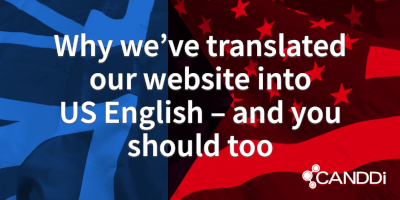Blog and News > marketing > Why we’ve translated our website into US English – and you should too
Why we’ve translated our website into US English – and you should too
Once when I was traveling home to the UK from the New York, I bought a bottle of whiskey at the airport for a friend back home. The cashier asked me where I was flying to, so she could issue the correct tax receipt.
“Manchester”, I said.
I suffered heaps of admin hassle later, as it turned out she’d assumed I meant Manchester, New Hampshire in the North-East USA, rather than Manchester, England.
The reason I’m telling this rather mundane travel story is to illustrate how America is such a big country that many people there rarely think about the world outside the 50 states.
At CANDDi, we’re proudly based in Manchester in the North of England. We firmly believe great tech businesses can be built anywhere, and if you call our office we certainly won’t try to hide our accents!
And yet when you’re selling into one of the world’s largest markets, language matters. And the language that matters is American English.

Why use American English?
Use words like ‘favourite’ and ‘whilst’ or tell people to ‘join the queue’, and Americans will probably think you’re a quaint curiosity from the world of Harry Potter, rather than a business worth trusting and buying from.
Use American English though, and not only will Americans be more comfortable with what they’re reading, but people in other parts of the world will be perfectly happy with it too. American English travels better to the rest of the world than British English travels into America.
That’s why we’ve translated our entire website into the language of the Stars and Stripes.
How to translate your website to US English
If you already have different websites set up for different regions of the world, you’re already sorted. But if you have one website for the whole world, translation to US English can be a useful tactic.
With hundreds of pages on our website, the project was no small feat. If you’re thinking of doing the same as us, here’s how we did it:
- We made a list of every page on our site, ordered by the most visited pages first. This should be possible with the help of your analytics software. The reason we did this was so we could translate our most popular pages first, creating the biggest impact early on in the process.
- We carefully pored over every paragraph and word, changing spellings and adjusting phrasings. How did we do this? There’s more on that below. For each web page we created a new page in a document that highlighted the changes needed to the text in red.
- All changes were double-checked by the person making the edits, and then checked again by a second person who acted as editor for the project. Sometimes one person can miss a detail no matter how many times they look at a document.
- We sent the document containing all the changes to our technical team, who modified the pages and published the new versions.
Given the size of our website and the fact that we had other priorities to focus on as well, this whole process took several weeks, but now we have a site that rolls out the welcome mat to prospective customers in the USA but also reads clearly to the rest of the world, too.
What about prices?
Just because you’re using US English doesn’t mean you have to solely display prices in US dollars. Your website developer will be able to advise on solutions like dynamically displaying the right currency based on a user’s settings or current location, or you can display multiple currencies on the same page.
What about SEO?
For us, this project was entirely about using language that maximized the impact of our content. If you worry your SEO may be impacted, we’d suggest talking to an expert about your specific circumstances before you begin.
Need more help?
Don’t worry, we’ve put together a guide on how to translate the text on your website to US English.
Don’t know your ‘favourites’ from your ‘favorites?’ Or your ‘queues’ from your ‘lines’?
We’ll sort you right out, mate. We’re here to help.